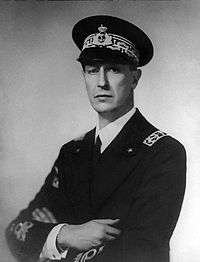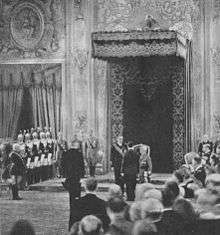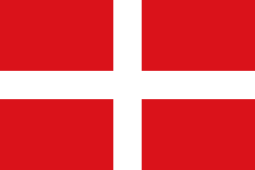Prince Aimone, Duke of Aosta
| Prince Aimone | |||||
|---|---|---|---|---|---|
 | |||||
| King of Croatia Disputed | |||||
| Reign | 18 May 1941 – 31 July 1943 | ||||
| Predecessor |
Charles IV (under Austria-Hungary) | ||||
| Successor | Title abolished | ||||
| Prime Minister | Ante Pavelić | ||||
| Duke of Aosta | |||||
| Held title |
3 March 1942 – 29 January 1948 | ||||
| Predecessor | Prince Amedeo, 3rd Duke | ||||
| Successor | Prince Amedeo, 5th Duke | ||||
| Born |
9 March 1900 Turin, Italy | ||||
| Died |
29 January 1948 (aged 47) Buenos Aires, Argentina | ||||
| Burial | Basilica of Superga[1] | ||||
| Spouse | Princess Irene of Greece and Denmark | ||||
| Issue | Prince Amedeo, 5th Duke of Aosta | ||||
| |||||
| House | House of Savoy-Aosta | ||||
| Father | Prince Emanuele Filiberto, 2nd Duke of Aosta | ||||
| Mother | Princess Hélène of Orléans | ||||
| Religion | Roman Catholic | ||||
Prince Aimone, 4th Duke of Aosta (Aimone Roberto Margherita Maria Giuseppe Torino; 9 March 1900 – 29 January 1948) was a prince of Italy's reigning House of Savoy and an officer of the Royal Italian Navy. The second son of Prince Emanuele Filiberto, Duke of Aosta he was granted the title Duke of Spoleto on 22 September 1904. He inherited the title Duke of Aosta on 3 March 1942 following the death of his brother Prince Amedeo, in a British prisoner of war camp in Nairobi.
From 18 May 1941 to 31 July 1943 he was designated king of the Independent State of Croatia (Croatian: Nezavisna Država Hrvatska, NDH) though he never ruled there.[2] He formally accepted the position and took the name Tomislav II (Croatian pronunciation: [tǒmislaʋ drûɡiː]), after the first Croatian king.[3][4] Later however he refused to assume the kingship in protest at the Italian annexation of the Dalmatia region,[5] and is therefore referred to in some sources as king designate.[6][7][8][9] Regardless, many sources refer to him as Tomislav II King of Croatia and the nominal head of the NDH during its first two years (1941–1943).[10][11][12][13][14] After the dismissal of Mussolini on 25 July 1943, the prince abdicated on 31 July as king on the orders of Victor Emmanuel III.
Early life
Prince Aimone Roberto Margherita Maria Giuseppe Torino of Savoy-Aosta was born in Turin the second son of Prince Emanuele Filiberto, Duke of Aosta (eldest son of Prince Amedeo, 1st Duke of Aosta (and sometime "King Amadeo I of Spain") by his wife, née Vittoria dal Pozzo, Principessa della Cisterna) and Princess Hélène of Orléans (daughter of Philippe, comte de Paris and Princess Marie Isabelle of Orléans). As his patrilinal great-grandfather was King Victor Emmanuel II of Italy, he is a member of the House of Savoy.
On 22 September 1904, he was given the title Duke of Spoleto for life.[15] On 1 April 1921, Prince Aimone became a member of the Italian Senate. Princes of the House of Savoy became members of the Senate at age 21, obtaining the right to vote at age 25.[16]
In 1929, twenty years after his uncle Luigi Amedeo, Duke of the Abruzzi had attempted to climb K2 in Karakorum, Prince Aimone led an expedition to Karakorum. A member of the expedition was Ardito Desio. Due to the failure to climb K2 twenty years earlier, Prince Aimone's expedition concentrated solely on scientific work.[17][18] He was afterwards awarded the 1932 Royal Geographical Society's Patron's Gold Medal for his work.[19]
After being romantically linked with Infanta Beatriz of Spain the daughter of King Alfonso XIII,[20] he married on 1 July 1939 in Florence with Princess Irene of Greece and Denmark the daughter of King Constantine I and Princess Sophie of Prussia. They had one son :
War years
Croatian throne

On 18 May 1941, In a ceremony at the Quirinal Palace, to which Ante Pavelić, the leader of the fascist Ustaše movement that had assumed power in Croatia in April 1941 after the invasion of Yugoslavia, led a delegation of Croats requesting that Italy's King Victor Emmanuel III name a member of the House of Savoy as King of Croatia. The Independent State of Croatia was a fascist puppet state that was partly under Italian and German control, covering most of present-day states of Croatia and Bosnia and Herzegovina, but its leaders tried to assert their legitimacy by instating a monarchy that would resemble the medieval Croatian state.
Aimone was then officially named King by his cousin Victor Emmanuel III.[21] On assuming the Crown of Zvonimir he took the regnal name Tomislav II in memory of Tomislav, the first Croatian king.[22] Originally on learning that he had been named King of Croatia he told close colleagues that he thought his nomination was a bad joke by his cousin King Victor Emmanuel III, though he accepted the crown out of a sense of duty.[23] The Italian Foreign Minister and Benito Mussolini's son in law Count Ciano's informants said of Aimone "The Duke doesn't give a damn about Croatia and wants only money, money and more money."[24] Ciano's diary noted a conversation between Aimone and himself, where Aimone was "proud of having been chosen King of Croatia, but has no exact idea of what he is supposed to do and is vaguely uneasy about it".[25]
He was due to be crowned in Duvno (Tomislavgrad), in modern-day Bosnia and Herzegovina, but he refused to go to Croatia due to the "Dalmatian question" which arose due to Italy taking some of Dalmatia's coastal territory. Aimone felt that Dalmatia "was a land that could never be Italianized" and was an obstacle to Italian-Croatian reconciliation.[26] Other reasons why he never went to Croatia were because of an ongoing insurgency, and that his safety could not be guaranteed.[24] Because of this he exercised what little power he had from Italy and Hungary,[27] however he never held any real authority throughout his reign as the Ustaše government had deprived the monarchy of most powers and reduced the status of the king to that of a figurehead.[23] In spite of this he did have some symbolic powers such as the ability to grant noble titles.[28] Count Gyula István Cseszneky de Milvány et Csesznek was the counselor to the King for Croatian affairs. Prince Aimone also established a Croatian office in Rome where he received confidential reports, official documents, and military, political and economic information from Croatia.[29]
After the dismissal of Mussolini, Aimone abdicated as king of Croatia on 31 July 1943 on the orders of Victor Emmanuel III.[27][30][31][32]
Prince Aimone succeeded to the title Duke of Aosta on 3 March 1942, following the death of his elder brother Prince Amedeo, 3rd Duke of Aosta, in a British Prisoner of War camp in Tanganyika.
In the Autumn of 1942, Aimone contacted Allied forces via his courier, the consul general Alessandro Marieni, about the possibility of a peace settlement between Italy and allied forces.[33] Secret talks would continue into 1943, motivated in part by the aim of preserving the royal dynasty of Savoy.[33]
Aftermath
In the late months of World War II, he became the commander of the Italian Naval Base of Taranto but he was dismissed from his post for his criticism of the judges that had found General Mario Roatta guilty of warcrimes.[34] During his naval career he reached the rank of Squadron Admiral.
Death
In 1947 following the birth of the Italian Republic the previous year, Prince Aimone left Italy for South America.[35] He died early the next year on 29 January 1948 in his temporary residence a hotel suite in the Borough of Recoleta in Buenos Aires, Argentina.[36] His son Prince Amedeo succeeded him as Duke of Aosta.
Titles, styles, honours, and arms
- 9 March 1900 - 21 September 1904: His Serene Highness Prince Aimone of Savoy-Aosta
- 22 September 1904 - 17 May 1941: His Royal Highness The Duke of Spoleto
- 18 May 1941 – 2 March 1942: His Majesty The King of Croatia, Duke of Spoleto
- 3 March 1942 – 31 July 1943: His Majesty The King of Croatia, Duke of Aosta
- 31 July 1943 - 30 January 1948: His Royal Highness The Duke of Aosta[37]
Honours
National honours
-
 Independent State of Croatia: Sovereign Knight Commander of the Military Order of the Iron Trefoil, 1st Class
Independent State of Croatia: Sovereign Knight Commander of the Military Order of the Iron Trefoil, 1st Class -
 Independent State of Croatia: Sovereign Knight Grand Cross of the Order of the Crown of King Zvonimir, Special Class
Independent State of Croatia: Sovereign Knight Grand Cross of the Order of the Crown of King Zvonimir, Special Class -
 Independent State of Croatia: Sovereign Recipient of the Medal of the Crown of King Zvonimir
Independent State of Croatia: Sovereign Recipient of the Medal of the Crown of King Zvonimir -
_crowned.svg.png) Italy: Knight Grand Collar of the Supreme Order of the Most Holy Annunciation[38][39]
Italy: Knight Grand Collar of the Supreme Order of the Most Holy Annunciation[38][39] -
_crowned.svg.png) Italy: Knight Grand Cordon of the Order of Saints Maurice and Lazarus
Italy: Knight Grand Cordon of the Order of Saints Maurice and Lazarus -
_crowned.svg.png) Italy: Knight Grand Cordon of the Order of the Crown of Italy
Italy: Knight Grand Cordon of the Order of the Crown of Italy -
_crowned.svg.png) Italy: Knight Grand Cordon of the Military Order of Savoy
Italy: Knight Grand Cordon of the Military Order of Savoy -
_crowned.svg.png) Italy: Knight of the Civil Decoration of Savoy
Italy: Knight of the Civil Decoration of Savoy -
_crowned.svg.png) Italy: Recipient of the Silver Medal of Military Valor
Italy: Recipient of the Silver Medal of Military Valor -
_crowned.svg.png) Italy: Recipient of the Bronze Medal of Military Valor
Italy: Recipient of the Bronze Medal of Military Valor -
_crowned.svg.png) Italy: Recipient of the Medal of Military Valor
Italy: Recipient of the Medal of Military Valor -
_crowned.svg.png) Italy: Recipient of the Medal of Honour for Long-time Maritime Navigation
Italy: Recipient of the Medal of Honour for Long-time Maritime Navigation
-
 Sovereign Military Order of Malta: Bailiff Knight Grand Cross of Justice of the Sovereign Military Order of Malta, 1st Class
Sovereign Military Order of Malta: Bailiff Knight Grand Cross of Justice of the Sovereign Military Order of Malta, 1st Class
-
Foreign honours
-
.svg.png) Greece: Knight Grand Cross of the Order of the Redeemer[39]
Greece: Knight Grand Cross of the Order of the Redeemer[39] -
.svg.png) Iran: Knight Grand Cordon of the Order of Pahlavi[40]
Iran: Knight Grand Cordon of the Order of Pahlavi[40] -
 Romania: Knight Grand Cross with Collar of the Order of Carol I[39]
Romania: Knight Grand Cross with Collar of the Order of Carol I[39] -
 United Kingdom: Recipient of the Victory Medal
United Kingdom: Recipient of the Victory Medal
Ancestry
References
- ↑ Savoy-Aosta
- ↑ Lemkin, Raphael (2008). Independent State of Croatia. The Lawbook Exchange, Ltd. pp. 252–56.
- ↑ dr. Marijan Rogić, Pod Zvonimirovom krunom (Under the crown of Zvonimir) Munchen 2008.
- ↑ Hrvoje Matković, Designirani hrvatski kralj Tomislav II. vojvoda od Spoleta. Povijest hrvatskotalijanskih odnosa u prvoj polovici XX.st. (Designated Croatian king Tomislav II, Duke of Spoleto. History of Croatian-Italian relationships in first half of the 20th century), Zagreb 2007.
- ↑ Rodogno, Davide; Fascism's European empire: Italian occupation during the Second World War; p.95; Cambridge University Press, 2006 ISBN 0-521-84515-7
"Devoid of political experience and ignorant of the Italian government's exact intentions, he [the Duke Aimone] refused to leave for Croatia, saying so in letters to Victor Emmanuel and Mussolini, in which he told them that the question of Dalmatia, 'a land that could never be Italianized', was an obstacle against any reconciliation with the Croats. Never, he declared, would he agree to be a king of a nation amputated from Italy." . - ↑ Pavlowitch, Stevan K.; Hitler's new disorder: the Second World War in Yugoslavia; p.289; Columbia University Press, 2008 0-231-70050-4
- ↑ Massock, Richard G.; Italy from Within; p.306; READ BOOKS, 2007 ISBN 1-4067-2097-6
- ↑ Burgwyn, H. James; Empire on the Adriatic: Mussolini's conquest of Yugoslavia 1941-1943; p.39; Enigma, 2005 ISBN 1-929631-35-9
- ↑ Royal Institute of International Affairs; Enemy Countries, Axis-Controlled Europe; Kraus International Publications, 1945 ISBN 3-601-00016-4
- ↑ Rezun, Miron (30 May 1995). Europe and war in the Balkans: toward a new Yugoslav identity. Greenwood Press. p. 62. ISBN 027595238X.
The duke agreed to accept the throne and became King Tomislav II of Croatia
- ↑ Friedman, Francine (22 January 2004). Bosnia and Herzegovina: a polity on the brink. Routledge. p. 130. ISBN 0415274354.
...nominally Croatia was ruled by the Italian Duke of Spoleto styled as King Tomislav II...
- ↑ Dedijer, Vladimir (1979). History of Yugoslavia. p. 573.
...The new king was given the title of Tomislav II...
- ↑ Romano, Sergio (1 March 1999). An outline of European history from 1789 to 1989. Berghahn Books. p. 130. ISBN 1571810765.
...the Duke of Spoleto, became king, with the name of Tomislav II...
- ↑ Salmaggi, Cesare; Pallavisini, Alfredo (1 May 1984). 2194 days of war. E Mayflower Books. p. 149. ISBN 0831789417.
...Croatia is constituted an independent nation under Tomislav II...
- ↑ The Peerage
- ↑ "Prince is Italian Senator". New York Times. 2 April 1921. p. 10.
- ↑ K2 - The Savage Mountain
- ↑ K2 2004 - 50 years later
- ↑ "List of Past Gold Medal Winners" (PDF). Royal Geographical Society. Retrieved 24 August 2015.
- ↑ "Milestones". Time Magazine. April 21, 1930.
- ↑ Packard, Reynolds (2005). Balcony Empire: Fascist Italy at War. Kessinger Publishing. p. 190. ISBN 1417985283.
- ↑ Worldstatesmen
- 1 2 Petacco, Arrigo (2005). A Tragedy Revealed: The Story of the Italian Population of Istria, Dalmatia, and Venezia Giulia. University of Toronto Press. pp. 26, 27. ISBN 0802039219.
- 1 2 Tomasevich, Jozo (2001). War and Revolution in Yugoslavia, 1941-1945: Occupation and Collaboration. Stanford University Press. p. 138. ISBN 0804736154.
- ↑ Ciano, Galeazzo (1947). Ciano's diary, 1939-1943. p. 343.
- ↑ Rodogno, Davide (2006). Fascism's European Empire: Italian Occupation During the Second World War. Cambridge University Press. p. 95. ISBN 0521845157.
- 1 2 "Duke gives up puppet throne". St. Petersburg Times. 21 August 1943. p. 10.
- ↑ Balkan royalty
- ↑ Avramov, Smilja (1995). Genocide in Yugoslavia. p. 238.
- ↑ Lemkin, Raphael; Power, Samantha (2005). Axis Rule In Occupied Europe: Laws Of Occupation, Analysis Of Government, Proposals For Redress. Lawbook Exchange. p. 253. ISBN 1584775769.
- ↑ "Foreign News: Hotel Balkania". Time Magazine. 9 August 1943. Retrieved 4 December 2009.
- ↑ B. Krizman, NDH između Hitlera i Mussolinija (Independent State of Croatia between Hitler and Mussolini,)p.102
- 1 2 Corvaja, Santi; Miller, Robert (2013). Hitler & Mussolini: The Secret Meetings. Enigma Books. p. 259.
- ↑ "A Duke Departs". Time Magazine. April 23, 1945.
- ↑ "Obituaries". Keesing's Record of World Events. April 1948. p. 9212.
- ↑ "Death of Duke of Aosta". Canberra Times. 31 January 1948. p. 1.
- ↑ Enache, Nicolas. La Descendance de Marie-Therese de Habsburg. ICC, Paris, 1996. pp. 206, 214. French.
- ↑ https://s-media-cache-ak0.pinimg.com/564x/a0/a1/42/a0a1423a56658af9bf2cd9906c1887fa.jpg
- 1 2 3 vivailre.it, Aimone wearing the Greek Italian and Romanian orders
- ↑ Live Journal
External links
![]() Media related to Tomislav II of Croatia, 4th Duke of Aosta at Wikimedia Commons
Media related to Tomislav II of Croatia, 4th Duke of Aosta at Wikimedia Commons
- "Crown of Zvonimir". Time Magazine. 1941-05-26. Retrieved 2008-08-14.
| Prince Aimone, Duke of Aosta Born: 9 March 1900 Died: 29 January 1948 | ||
| Italian nobility | ||
|---|---|---|
| Preceded by Amedeo |
Duke of Aosta 2nd creation 1942–1948 |
Succeeded by Amedeo |
| Vacant Title last held by Charles IV |
— DISPUTED — King of Croatia 1941–1943 |
Vacant |
.svg.png)